#gay ringos also known as epsteins
Text
I stumbled across the book ‘Beatleology: A Magical Mystery Tour To Discover Your Inner Beatle’ or alternatively: Astrology but narrow it down to four archetypes and make everything a beatle reference’

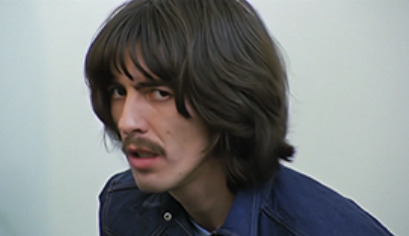
gay Ringos, also known as Epsteins.

#honestly.... Ringo is the Beatle most likely to be a Russian Orthodox priest#I will not elaborate#However George not being able to be an aerobics instructor makes perfect sense#I can't get over it#gay ringos also known as epsteins
90 notes
·
View notes
Text
Who would the Sanders Sides be as the Beatles?
Alright, everyone, this is gonna be a Long Post so buckle up.
I was thinking about which of the Sanders Sides would fit which of The Beatles, and this is what I came up with. Here we go.
Anxiety/Virgil as Ringo Starr:

1. Later addition to the group and lack of initial acceptance.
Ringo was added to the Beatles later than any of the other members, being the replacement for their former drummer, Pete Best. After Ringo was added to the band, many fans were outraged, and they made their voices heard.
After his appearance at the Cavern Club the following day, Best fans, upset by his firing, held vigils outside his house and at the club shouting "Pete forever! Ringo never!"[x] Harrison received a black eye from one of the upset fans, and Epstein, whose car tyres they had flattened in anger, temporarily hired a bodyguard to ensure his safety.[x]
Eventually, Ringo was accepted by fans as a member of the band and began receiving as much fan mail as the other band members, securing his place as a member of The Beatles.
By November 1962 Starr had been accepted by Beatles fans, who were now calling for him to sing songs.[x] Soon afterwards, he began receiving an amount of fan mail equal to that of the others, which helped to secure his position within the band.[x]
He was a source of inspiration for several songs written at the time, including Penny Valentine's "I Want to Kiss Ringo Goodbye" and Rolf Harris's "Ringo for President".[x] In 1964, "I love Ringo" lapel pins outsold all other Beatles merchandising.[x]
During live performances, the Beatles continued the Starr Time routine that had been popular among his fans: Lennon would place a microphone in front of Starr's kit in preparation for his spotlight moment and audiences would erupt in screams.[x]
Both Ringo and Virgil had later additions to their respective groups, a lack of initial acceptance, and eventual very wide acceptance from others.
2. Exclusion from their group.
As the Beatles’ music evolved, Ringo’s drumming wasn’t needed as often for their songs anymore, and he was eventually only getting one track per album, though he was content with that.
He was also feeling increasingly isolated from the musical activities of his bandmates, who were moving past the traditional boundaries of rock music into territory that often did not require his accompaniment; during recording sessions he spent countless hours playing cards with their road manager Neil Aspinall and roadie Mal Evans while the other Beatles perfected tracks without him.[x]
In a letter published in Melody Maker, a fan asked the Beatles to let Starr sing more; he replied: "[I am] quite happy with my one little track on each album".[x]
During the recording of Sgt. Pepper’s, Ringo wasn’t given as much freedom in how he could play his instrument, often being given specific instructions on how and what to play.
Although the Beatles had enjoyed widespread commercial and critical success with Sgt. Pepper, the long hours they spent recording the LP contributed to Starr's increased feeling of alienation within the band.
He commented: "[It] wasn't our best album. That was the peak for everyone else, but for me it was a bit like being a session musician ... They more or less direct me in the style I can play."[x][x]
His inability to compose new material led to his input being minimised during recording sessions; he often found himself relegated to adding minor percussion effects to songs by McCartney, Lennon and Harrison.[x]
The Beatles began to argue with one another as tensions rose between them. Paul criticized Ringo’s drumming, making Ringo leave the band and go on holiday for two weeks to get away from the other members.
During the recording of the White Album, relations within the band became openly divisive.[x] As the sessions progressed, their collective group dynamic began to decay; at times only one or two Beatles were involved in the recording for a track.[x]
Starr had grown weary of McCartney's increasingly overbearing approach and Lennon's passive-aggressive behaviour, which was exacerbated by Starr's resentment of Yoko Ono's near-constant presence.[x]
After one particularly difficult session during which McCartney had harshly criticised his drumming, Starr quit the band for two weeks, taking a holiday with his family in Sardinia on a boat loaned by Peter Sellers.[x]
When Ringo returned from his vacation, he found that George gave him a ‘welcome-back’ gift.
He returned to the studio two weeks later,[x] to find that Harrison had covered his drum kit in flowers as a welcome-back gesture.[x]
Both Ringo and Virgil were excluded by the other members of their groups and were often restricted in what they were allowed to do. They both took some time away from the other members, came back, and received kind gifts from one of the other members of the group. (George giving Ringo flowers and Patton giving Virgil a card.)
3. Other forms of subtle ostracization from peers.
Ringo was often joked about among the Beatles, but if you look at any given Beatles interview, you’ll find them joking about each other a lot, so Ringo was not a specific target of joking for the band, but I still included some of their interview moments from/about Ringo.

(source) [Image description: Reporter:”Is Ringo the best drummer in the world?” John:”Ringo isn’t even the best drummer in the Beatles.”]
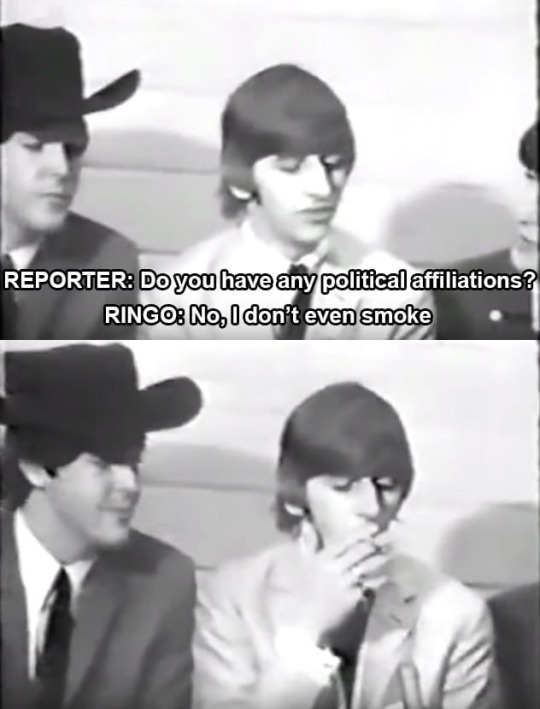
(source) [image description: Interviewer:”Do you have any political affiliations?” Ringo:”No, I don’t even smoke” *brings his cigarette up to his mouth*]
I just felt like this would be a kind of thing Virgil would do.
Logic/Logan as George Harrison:
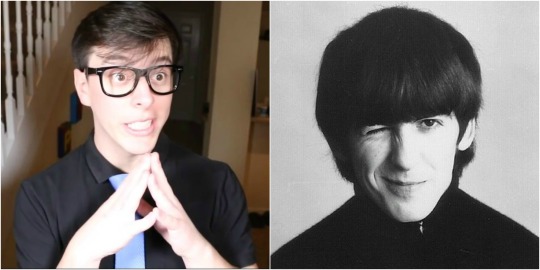
-The “forgotten member”
Each one of the Beatles has something memorable about them. For Paul and John, it was their huge roles in the band as the composers and singers on a majority of the Beatles’ songs. For Ringo, it was his large nose and his... difficulty singing. George, however, didn’t have much of a memorable trait about himself (until the later years when he became fascinated with Indian music and their culture.)
Often referred to as "the quiet Beatle",[x][x] Harrison embraced Hinduism and helped broaden the horizons of his fellow Beatles as well as their Western audience by incorporating Indian instrumentation in their music.[x]
The impromptu musical education Harrison received while playing long hours with the Beatles, as well as the guitar lessons he took from Tony Sheridan while they briefly served as his backing group, laid the foundations of his sound and of his quiet, professional role within the group; he was later known as "the quiet Beatle".[x][x]
George Harrison is similar to Logan in being, “the quiet Beatle,” as Logan was called, “the least popular character,” by Virgil.
Though I do hope that we, as fanders, can grow to appreciate logic more, and I can already see that happening with posts like this going around and with it currently being Logic Appreciation Week.
Morality/Patton as John Lennon:
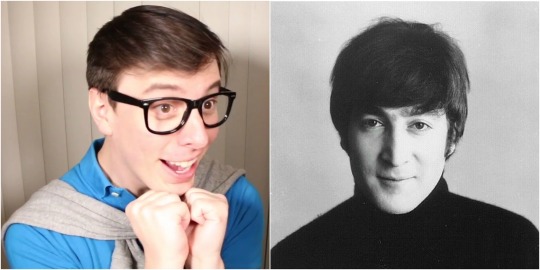
1. I am the Walrus
I’m sure many of you recall in the My Personality Q&A video, the sides were asked “How are you feeling right now?” and told to answer with only a song title. Patton answered with, “I am the Walrus,” a song by The Beatles, sung by John Lennon.
In a later Beatles song, “Glass Onion,” John Lennon sings, “Well here’s another clue for you all, the Walrus was Paul.”
Many believe this to be hinting to the famous, “Paul is Dead,” theory because Walruses are a symbol of death in some cultures, but it would take hours to cover the basic evidence for that theory so I will spare you from that rant.
This line is most likely referring to the cover of The Beatles Album; “Magical Mystery Tour,” and The Beatles’ movie of the same name, where The Beatles are dressed up in different animal costumes.

[image description: the cover of Magical Mystery Tour, showing the Beatles in different animal costumes.]
I realize the song lyrics said, “the Walrus was Paul,” and not John, but Paul was, in fact, not the true wearer of the Walrus Costume.
The Beatles Bible.com states that while it was claimed Paul wore the Walrus costume, John Lennon was the true wearer on both the cover of the album, “Magical Mystery Tour,” and in the movie of the same name.
It was later claimed that it was, in fact, McCartney in the walrus costume, and that this accounted for Lennon's line that "the walrus was Paul" in Glass Onion. However, the Magical Mystery Tour film clearly shows McCartney playing bass while wearing the hippo costume, and Lennon seated at the piano dressed as a walrus.
(Source)
2. Peace Activism
John Lennon is known for his work in bringing peace and love to this world. He was very anti-war and pro-peace. Which reminds me of how Patton always sees the good in people and always tries to do the right thing.
Lennon wrote and recorded "Give Peace a Chance". Released as a single, it was quickly taken up as an anti-war anthem and sung by a quarter of a million demonstrators against the Vietnam War in Washington, DC, on 15 November, the second Vietnam Moratorium Day.[x][x]
In 1973, Lennon contributed a limerick called "Why Make It Sad To Be Gay?" to Len Richmond's The Gay Liberation Book.[x]
3. A Role-Model Status and Quick Wit
Paul stated in an interview that John was the leader, and someone they looked up to. Patton is also the “dad figure” that people look up to.
John was described as having “quick wit,” a trait Patton also possess, in making puns (believe me, your wit has to be quick to make a pun about a situation before it passes, I know.)
In a 1987 interview, McCartney said that the other Beatles idolised John: "He was like our own little Elvis ... We all looked up to John. He was older and he was very much the leader; he was the quickest wit and the smartest."[x]
Princey/Roman as Paul McCartney:

1. The Cute One
Paul was often referred to as “the cute Beatle” and Roman is the most looks-obsessed Sanders Side.
Their fans' hysteria became known as "Beatlemania", and the press sometimes referred to McCartney as the "cute Beatle".[x][x[x]
Paul has taken a selfie, something Roman has also done.
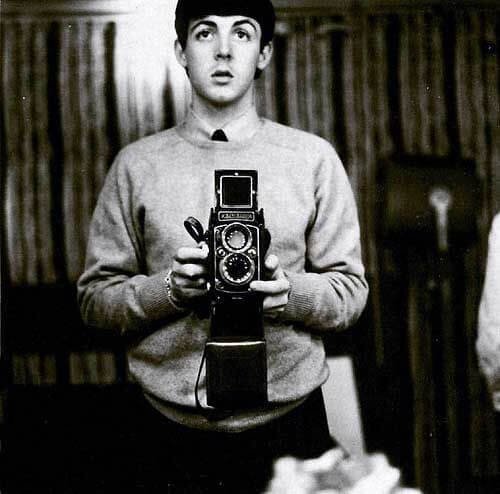
(Source) [image description: Paul McCartney taking a picture of himself in a mirror]
2. Creative Motivation
When the Beatles found themselves in times of trouble, Paul McCartney came to them, speaking words of wisdom, “Be Creative!”
That was really cheesy I’m sorry but I had to.
In instances where the Beatles were feeling depressed or down, Paul would always encourage them to keep up their creativity to continue their productivity.
Upon the end of the Beatles' performing career, McCartney sensed unease in the band and wanted them to maintain creative productivity. He pressed them to start a new project, which became Sgt. Pepper's Lonely Hearts Club Band, widely regarded as rock's first concept album.[x]
Epstein's death in August 1967 created a void, which left the Beatles perplexed and concerned about their future.[x] McCartney, stepping in to fill that void, gradually became the de facto leader and business manager of the group Lennon had once led.[x]
His first creative suggestion after this change of leadership was to propose that the band move forward on their plans to produce a film for television, which was to become Magical Mystery Tour.
3. Being Savage
Some of you may know about John’s second wife, Yoko Ono, and those of you who don’t, I envy you. Yoko was not liked by any of the Beatles, and she is known for being the main factor in the Beatles eventual breakup.
One, very savage thing Paul did during the recording of the Beatles’ song, “Get Back,” reminds me a Lot of something Roman might do.
In 1980, Lennon stated that "there's some underlying thing about Yoko in there", saying that McCartney looked at Yoko Ono in the studio every time he sang "Get back to where you once belonged."[x]
And that concludes this post! I hope you all appreciate all the time and effort I put into research for this. Thanks for reading! :)
#sanders sides#thomas sanders#The Beatles#anxiety sanders#virgil sanders#patton sanders#logan sanders#logic sanders#roman sanders#princey sanders#john lennon#paul mccartney#george harrison#ringo starr#logan appreciation week#logic appreciation week#sanders sides appreciation month#sanderssidesappreciationmonth#my posts#pantton-sandacers posts
126 notes
·
View notes
Text
Brian Epstein - The Man That Made The Beatles
NEWS Days
New Post has been published on https://ellalinea.com/brian-epstein-the-man-that-made-the-beatles/
Brian Epstein - The Man That Made The Beatles
Paul McCartney has often been heard claiming that if there was ever a fifth Beatle, it was Brian Epstein. Brian was the non-band member who made the most contributions to their success. He was a very successful manager for groups besides the Beatles, and music entrepreneur with his family company NEMS – North End Music Stores.
Brian was the older of two sons in a Jewish English family that ran a small chain of well-known furniture stores in Liverpool. Brian reluctantly joined the family business after expressing to this father that he wanted to be a dress designer. He was never a strong student; being removed from a couple of boarding schools, and after a short stint as a floor salesman, he was drafted in to the army.
Brian’s time in the army was as a data entry clerk. He followed that with more work in the furniture business and was soon made a director of the NEMS. It was around 1955, when young Brian confessed to a psychiatrist that he was a homosexual. At the time, it was illegal to be gay, and Brain headed to London. He had an interest in acting and enrolled in the Royal Academy of Dramatic Arts.
It was Brian’s drive for business that led him to leave the program in his third year. He was much more interested in the production side of theatre and film. He returned to London and took over the newest music store in his family’s chain. He worked diligently at making the store a success, and it had a reputation amongst the new hip music scene that was emerging. This was when Brian noticed the Beatles. They had been featured in a local music scene magazine, he’d seen them on posters, and he’d heard about them from others. They had released a single, My Bonnie, whose growing sales in the music store caught his attention too.
In November of 1961, Epstein made a point of visiting The Cavern for one of the lunchtime shows that featured The Beatles. Immediately, Brian was struck by the personal charm and charisma of the group as they performed. Their beat and musicality was different and he found them refreshing, witty and humourous as they entertained. The band met Brian briefly in their tiny dressing room after the show, but barely a conversation took place. Later that night, Brian expressed to a friend how tremendous he found the group to be and immediately recognized their potential. He started attending The Cavern regularly when The Beatles were performing. He investigated their existing managerial arrangement, and sensing an opening, he proposed becoming their new manager in December 1961.
The band members were skeptical of Brian at first; he appeared to be a successful businessman with a nice car, fancy suits, and a professional image. Why would he want to work with them – young, green and knowing so little about business?
Family members advised all the boys, especially since a few were under the legal age of 21 to sign a contract. But Brian was savvy about the music business. They agreed to a five-year contract, which gave Brian Epstein 25 % of the gross income. Brian had developed a management division from NEMS and convinced his family that the management would only take up his effort part time. The Beatles Brian did not. He did, however, sign Lennon and McCartney the following year to a publishing contract with NEMS for three years.
Brian may have been new to management, but he knew what image was about and what the public wanted. He influenced the early dress code and style of The Beatles. He encouraged them to clean up their act as far as smoking, swearing , drinking and eating on stage, pushing for a more polished act. He got them to bow together at the end of the performance. The boys were reluctant at first, but the changes had impact. They started playing better venues and became more organized about their playing commitments.
Brian worked diligently at getting The Beatles their first contract. He personally paid for a demo tape for an opportunity at Decca Records, but a contract didn’t follow. Eventually, in May of 1962 he was able to get the attention of George Martin at Parlophone, a division of EMI. Martin felt EMI had nothing to lose and offered a strange contract – the band would receive one penny from every record sold. In January 1967, Epstein renegotiated a contract with EMI for nine years, at a much better rate.
As manager of The Beatles, Brian Epstein had an unusual job description. When it was decided that drummer Pete Best was to be dismissed, the job of letting him go fell to Brian. In August of 1962, Brian Epstein fired Pete Best, with no explanation. Best’s position wasn’t immediately filled, and Brian even offered it to a friend of Pete Best’s from another group The Big Three. The spot was offered to Ringo Starr and the rest is history. As soon as Beatlemania hit, Brian was kept very busy with touring, television and film work between 1962 and 1965. By 1966, the band wanted to stop touring against Brian’s advice, but their careers were changing as a group and individually.
Brian was an integral part of the Beatles make up. He was a good friend to each of them. He was John’s best man at his wedding to Cynthia, and godfather to son Julian. The boys were quite defensive too of Brian. They wouldn’t let anyone working around them use homophobic put downs or off the cuff jokes about Brian’s orientation.
Apart from The Beatles, Brian managed other group at the time including : The Dakotas, Gerry & The Pacemakers, Cilla Black, Billy J. Kramer and the Remo Four. He also stood behind the politicians who campaigned to legalize cannabis, unsuccessfully. He grew dependent on amphetamines and sadly died in his home in London of an accidental overdose. Brian was 32.
Brian’s brother Clive assumed control of NEMS following Brian’s death. He was the second largest shareholder in the company. At one point up and coming producer Robert Stigwood tried to buy out NEMS but was kept at bay by the Beatles themselves. They had no trust of Stigwood, someone they didn’t know, and had immense trust in Brian. In later years they discussed how they never read any of the contracts he had them sign.
Brian Epstein’s autobiography, A Cellarful of Noise, was published in October in 1964 and later outside the UK. Epstein’s assistant of many years, Derek Taylor, did the ghost-writing.
#beatles#brian#brian epstein#brian epstein (celebrity)#brian epstein (musical artist)#brian epstein beatles#brian epstein beatles manager#brian epstein interview#brian epstein interview 1967#epstein#epstein: the man who made the beatles#spirituality and the death of brian epstein#the#the beatles#the beatles (album)#the beatles (band)#the beatles (musical group)#the fifth beatle
0 notes